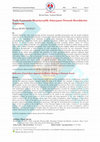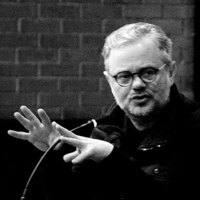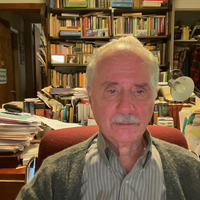Papers by Huriye Bostanoğlu
Turk Kulturu Ve Haci Bektas Veli-arastirma Dergisi, Mar 23, 2022
Turk Kulturu Ve Haci Bektas Veli-arastirma Dergisi, Mar 13, 2020
Sosyal, İnsan ve İdari Bilimlerde Güncel Yaklaşımlar , 2023

Öz Osmanlı Devleti'nde tarih yazım geleneği devletin kuruluşuyla paralellik göstermemiş olup ilk ... more Öz Osmanlı Devleti'nde tarih yazım geleneği devletin kuruluşuyla paralellik göstermemiş olup ilk önemli örneklerin ortaya çıkması II. Murad devrini bulmuştur. Osmanlı tarihi hakkında daha detaylı bilgiler içeren müstakil kaynakların telifi ise tarih yazıcılığının devlet tarafından da teşvik edilip çalışmaların hız kazandığı II. Bâyezid devrinde gerçekleşebilmiştir. Literatürde kronik olarak zikredilen kaynakların özellikle arşiv kaynaklarının bulunmadığı ilk devirlere ait bilgileri efsaneler, menakıbnameler ekseninde mitolojik unsurlarla açıklıyor olması söz konusu kaynakların güvenilirliği problemini ortaya çıkarmıştır. Kaynaklarda mitolojik motiflerin ön planda olması, esasında tarihi verileri bunların üzerinden kurgulamak üzere tercih edilen bir yöntem değildir. Bilakis eski devirlerden beri Türk İslam kaynaklarında ve farklı inançlara ait tarih yazımında da başvurulan bir izah yöntemidir. Osmanlı kroniklerinin söz konusu izah yönteminde tercih ettiği vasıtalardan birisi meşruiyetçilik olup, herhangi bir gücün, iktidarın ya da zaferin kabul edilebilir hale getirilmesi ve bunu gerçekleştirebilmek amacıyla toplumun değer yargılarına uygun argümanların kullanılması biçimidir. Osmanlı kroniklerinde meşruiyetçilik vurgusunun kullanımı, etnik aidiyet olarak Oğuz Han'a dayanmanın haricinde, yönetme hakkının ilâhî kaynağı olarak İslâm ve buna bağlı manevî anlam taşıyan rüyalarla ifade edilmektedir. Ayrıca sûfî tarikatlarla olan münasebetler ile ebediyeti, gücü temsil eden ağaç metaforu aynı amaca yönelik kaynaklarda işlenmiştir. Bahsi geçen kavramlar, Osmanlı Devleti'nin kuruluşuna dair tartışmaların da ana başlıkları olmakla beraber bu çalışmada herhangi bir kuruluş problemine çözüm aranmayacaktır. Çalışmada Osmanlı kroniklerine yansımış meşruiyetçilik hususunun İslâm, mutasavvıf çevre ve ağaç sembolü bağlamında işlenme biçimleri, gerekçe ve örnekleriyle birlikte açıklanmaya çalışılacaktır.
Huriye BOSTANOĞLU * Selenge ırmağından taşınan Türkmen adı Yıllar sonra Selene'de kışladı Selinus... more Huriye BOSTANOĞLU * Selenge ırmağından taşınan Türkmen adı Yıllar sonra Selene'de kışladı Selinus'lar Selene'yi dışladı Dil kıymetin bilmez ise kaç para? **
Osmanlı Sarayında Helvahaneden Gelen Şifa: Saray Eczası, 2023
Osmanlılarda Issız Diyarların Kültür Merkezleri: Kervansaraylar, 2023
Book of 1st International Conference on Scientific and Innovative Studies https://as-proceeding.c... more Book of 1st International Conference on Scientific and Innovative Studies https://as-proceeding.com/index.php/icsis 1st International Conference on Scientific and Innovative Studies ICSIS 2023: edited by Umut Özkaya.
Edirne'de Çok Amaçlı Müesseseler: Zaviyeli Camiler, 2022

Yedi İklim Çar Köşede Hacı Bektaş Veli, 2022
Bektashism is a sect that was founded by Hadji Bektash Veli in Anatolia and
found the opportunit... more Bektashism is a sect that was founded by Hadji Bektash Veli in Anatolia and
found the opportunity to spread over a wide area from Egypt to Rumelia. There is no
official record of the life and activities of Hadji Bektash Veli, the founder of the sect,
especially before he came to Anatolia, except for the anecdotal reports. The earliest
sources mentioning Hünkar’s life are from the XIV. and XV. It was written between the
centuries, and only in its Velayetname there is more detailed information compared to
other sources. It is a common opinion that before coming to Anatolia, Hadji Bektash
Veli was a Haydari dervish who lived in accordance with the Yesevi traditions, came
to Anatolia under the domination of the Mongols and perhaps later, and settled in
Suluca Karaöyük in Kırsehir after joining the Vefai sect but not participating in the
Babai movement comes out. The part after Suluca Karaöyük was also written in the
years after Hünkar’s death. There is no information on whether Hünkâr is married and
has children in his Velayetname and other sources. However, some of the Bektashis
reintegrated the view that he set out as a sequestered dervish in Suluca Karaöyük with
a legend and accepted that Hünkar’s ancestry was his biological sons. Thus, those who
claim to be descendants of Hünkâr (Çelebiler/dedegan) and who are called biyological
lineage (bel evladı) appear as Bektashis who later joined the sect called road sons
(Babagan/dedebaba). The life story and historical identity of Hadji Bektash Veli up
to this point have been shaped around myths, legends and legends and transferred to
the present day.
Hadji Bektash Veli is not a dervish who acted alone in Suluca Karaöyük, but a
member of a tribe that bears his name. This tribe lived in congregations in Aksaray, in
the Eyubili subdistrict. Members of the tribe claimed that they were the son of Hünkâr
(Çelebiler/dedegan), used various foundations of the main convent in the region.
Bektashism; which had an institutional organization by Balım Sultan, found the
opportunity to spread owing to the dervish lodges and zaviyes established in the area
of domination of the Ottoman Empire. Although hundreds of dervish lodges operated
under the sect, there are limited examples of buildings that took the full name of
Hünkâr in the Ottoman geography, apart from the central dervish lodge in Suluca
Karaöyük. The maqam zawiya, which we have identified in a limited number so far
which are located in the Susadı village of Eyübili subdistrict in the settlement area
of Bektashlı tribe in Aksaray, in the city of Dimetoka and in the Yeniceri garrison in
Cairo (Kayrü’l-ayn) in Egypt. The zaviye in the Susadı village was built during the Karamanoğulları period before the Ottomans and was located in an area close to the
main dervish lodge in the 16th century. It is understood from the early architectural
features that it was built in the form of a mosque with tabhane (zaviye). The other
building located in the city of Dimetoka, where there is an example of sectarianism
in Bektashism, appears as a maqam zawiya, about which much information has not
been obtained so far.
Türk Kültürü ve Hacı Bektaş Veli Araştırma Dergisi, 2020
Osmaniye Araştırmaları I, 2020
Osmaniye Araştırmaları I, 2020
İstanbul Üniversitesi, Sep 1, 2020
Türk Kültürü ve Hacı Bektaş Veli Araştırma Dergisi , 2022
Atatürk Ansiklopedisi , 2021
Engellilik Tarihi Yazıları I, 2020
Rumeli'de Osmanlı Vakıfları Üzerine Araştırmalar : Bulgaristan, 2020











Uploads
Papers by Huriye Bostanoğlu
found the opportunity to spread over a wide area from Egypt to Rumelia. There is no
official record of the life and activities of Hadji Bektash Veli, the founder of the sect,
especially before he came to Anatolia, except for the anecdotal reports. The earliest
sources mentioning Hünkar’s life are from the XIV. and XV. It was written between the
centuries, and only in its Velayetname there is more detailed information compared to
other sources. It is a common opinion that before coming to Anatolia, Hadji Bektash
Veli was a Haydari dervish who lived in accordance with the Yesevi traditions, came
to Anatolia under the domination of the Mongols and perhaps later, and settled in
Suluca Karaöyük in Kırsehir after joining the Vefai sect but not participating in the
Babai movement comes out. The part after Suluca Karaöyük was also written in the
years after Hünkar’s death. There is no information on whether Hünkâr is married and
has children in his Velayetname and other sources. However, some of the Bektashis
reintegrated the view that he set out as a sequestered dervish in Suluca Karaöyük with
a legend and accepted that Hünkar’s ancestry was his biological sons. Thus, those who
claim to be descendants of Hünkâr (Çelebiler/dedegan) and who are called biyological
lineage (bel evladı) appear as Bektashis who later joined the sect called road sons
(Babagan/dedebaba). The life story and historical identity of Hadji Bektash Veli up
to this point have been shaped around myths, legends and legends and transferred to
the present day.
Hadji Bektash Veli is not a dervish who acted alone in Suluca Karaöyük, but a
member of a tribe that bears his name. This tribe lived in congregations in Aksaray, in
the Eyubili subdistrict. Members of the tribe claimed that they were the son of Hünkâr
(Çelebiler/dedegan), used various foundations of the main convent in the region.
Bektashism; which had an institutional organization by Balım Sultan, found the
opportunity to spread owing to the dervish lodges and zaviyes established in the area
of domination of the Ottoman Empire. Although hundreds of dervish lodges operated
under the sect, there are limited examples of buildings that took the full name of
Hünkâr in the Ottoman geography, apart from the central dervish lodge in Suluca
Karaöyük. The maqam zawiya, which we have identified in a limited number so far
which are located in the Susadı village of Eyübili subdistrict in the settlement area
of Bektashlı tribe in Aksaray, in the city of Dimetoka and in the Yeniceri garrison in
Cairo (Kayrü’l-ayn) in Egypt. The zaviye in the Susadı village was built during the Karamanoğulları period before the Ottomans and was located in an area close to the
main dervish lodge in the 16th century. It is understood from the early architectural
features that it was built in the form of a mosque with tabhane (zaviye). The other
building located in the city of Dimetoka, where there is an example of sectarianism
in Bektashism, appears as a maqam zawiya, about which much information has not
been obtained so far.
found the opportunity to spread over a wide area from Egypt to Rumelia. There is no
official record of the life and activities of Hadji Bektash Veli, the founder of the sect,
especially before he came to Anatolia, except for the anecdotal reports. The earliest
sources mentioning Hünkar’s life are from the XIV. and XV. It was written between the
centuries, and only in its Velayetname there is more detailed information compared to
other sources. It is a common opinion that before coming to Anatolia, Hadji Bektash
Veli was a Haydari dervish who lived in accordance with the Yesevi traditions, came
to Anatolia under the domination of the Mongols and perhaps later, and settled in
Suluca Karaöyük in Kırsehir after joining the Vefai sect but not participating in the
Babai movement comes out. The part after Suluca Karaöyük was also written in the
years after Hünkar’s death. There is no information on whether Hünkâr is married and
has children in his Velayetname and other sources. However, some of the Bektashis
reintegrated the view that he set out as a sequestered dervish in Suluca Karaöyük with
a legend and accepted that Hünkar’s ancestry was his biological sons. Thus, those who
claim to be descendants of Hünkâr (Çelebiler/dedegan) and who are called biyological
lineage (bel evladı) appear as Bektashis who later joined the sect called road sons
(Babagan/dedebaba). The life story and historical identity of Hadji Bektash Veli up
to this point have been shaped around myths, legends and legends and transferred to
the present day.
Hadji Bektash Veli is not a dervish who acted alone in Suluca Karaöyük, but a
member of a tribe that bears his name. This tribe lived in congregations in Aksaray, in
the Eyubili subdistrict. Members of the tribe claimed that they were the son of Hünkâr
(Çelebiler/dedegan), used various foundations of the main convent in the region.
Bektashism; which had an institutional organization by Balım Sultan, found the
opportunity to spread owing to the dervish lodges and zaviyes established in the area
of domination of the Ottoman Empire. Although hundreds of dervish lodges operated
under the sect, there are limited examples of buildings that took the full name of
Hünkâr in the Ottoman geography, apart from the central dervish lodge in Suluca
Karaöyük. The maqam zawiya, which we have identified in a limited number so far
which are located in the Susadı village of Eyübili subdistrict in the settlement area
of Bektashlı tribe in Aksaray, in the city of Dimetoka and in the Yeniceri garrison in
Cairo (Kayrü’l-ayn) in Egypt. The zaviye in the Susadı village was built during the Karamanoğulları period before the Ottomans and was located in an area close to the
main dervish lodge in the 16th century. It is understood from the early architectural
features that it was built in the form of a mosque with tabhane (zaviye). The other
building located in the city of Dimetoka, where there is an example of sectarianism
in Bektashism, appears as a maqam zawiya, about which much information has not
been obtained so far.